List of sunken battlecruisers
Sunken battlecruisers are large capital ships built in the first half of the 20th century that were either destroyed in battle, scuttled, or destroyed in a weapon test. They were similar in size and cost to a battleship, and typically carried the same kind of heavy guns, but battlecruisers generally carried less armor and were faster. The first battlecruisers[Note 1] were developed in the United Kingdom in the first decade of the century, as a development of the armored cruiser, at the same time the dreadnought succeeded the pre-dreadnought battleship. The original aim of the battlecruiser was to hunt down slower, older armored cruisers and destroy them with heavy gunfire. However, as more and more battlecruisers were built, their opponents became ships of their own type, not slower, weaker vessels.[3]
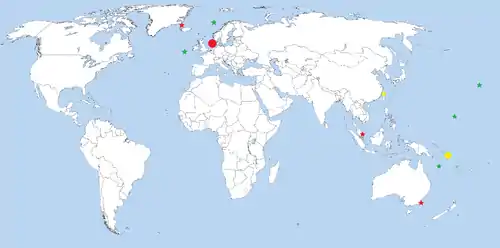
In World War I, the thin armor of British battlecruisers did not serve them well in combat with their better-armored German counterparts and three were lost at the Battle of Jutland in 1916. SMS Lützow, a German battlecruiser, was also sunk during the battle. Five German battlecruisers were scuttled by their crews in 1919 to prevent their seizure by the Royal Navy after the First Armistice at Compiègne in 1918.
Between the World Wars, the Washington Naval Treaty of 1922 limited the number and tonnage of capital ships that could be retained. Many battlecruisers were scrapped during this period, though HMAS Australia, the sole Australian battlecruiser, was scuttled to comply with the treaty. One provision of the treaty allowed nations to convert two battlecruisers then under construction into aircraft carriers and both the Empire of Japan and the United States took advantage of the opportunity. The British also converted all three of their "light battlecruisers" into aircraft carriers even though they were not subject to the treaty. The Japanese rebuilt their four remaining battlecruisers into fast battleships during the 1930s.
World War II took a heavy toll on the remaining battlecruisers, both converted and unconverted. In contrast to World War I, where all four ships were lost to gunfire, only two were sunk solely by guns. Two battlecruisers were sunk by a combination of gunfire and aerial attack, four were sunk solely by aircraft and two were sunk by submarines. The largest loss of life in the sinking of a battlecruiser was the 1,415 killed in the sinking of HMS Hood during her confrontation with the German battleship Bismarck in 1941. Of the three surviving World War II battlecruisers, two were scrapped after the war and one, USS Saratoga, was sunk by nuclear weapon tests in 1946.
Losses
The first combat losses of battlecruisers occurred during World War I, as a result of the Battle of Jutland between the Royal Navy and the Imperial German Navy on 31 May 1916. The three British ships—Invincible, Indefatigable, and Queen Mary—were all sunk by magazine explosions, with heavy loss of life.[4] SMS Lützow had been hit several times below the waterline by British shells during the battle and took on a lot of water after the battle. Later that night, Lützow had so much water aboard that she threatened to capsize; the crew was ordered to abandon ship and a German destroyer finished her off with two torpedoes.[5] The next combat losses were a quarter century later during World War II, when the British intercepted a German force attempting to break out into the Atlantic to attack supply convoys. Shortly after the Battle of the Denmark Strait began on 24 May 1941, a shell from the German battleship Bismarck hit Hood, causing its magazine to explode with massive loss of life. Six months later, the battleship Prince of Wales and the battlecruiser Repulse attempted to intercept Japanese troop convoys approaching the Malay Peninsula. They were spotted by Japanese aircraft en route and sunk by torpedo bombers on 10 December.[6]
Several battlecruisers survived World War I only to be scuttled in its aftermath. The five German battlecruisers that survived World War I—Von der Tann, Moltke, Seydlitz, Derfflinger, Hindenburg—were interned at Scapa Flow pending the signing of a peace treaty between Germany and the Allies. The commander of the German ships in Scapa, Rear Admiral Ludwig von Reuter, thought the British were going to seize the ships immediately after the expiration of the Armistice, and preemptively ordered the ships be scuttled on the morning of 21 June 1919 to keep them out of British hands.[7] The Royal Australian Navy scuttled Australia in 1924 to comply with the terms of the Washington Naval Treaty.[8]
Half a dozen of the surviving battlecruisers (including three under construction) were converted into aircraft carriers during the 1920s. All three of the Courageous-class battlecruisers were converted. Courageous's aircraft were hunting for submarines shortly after the beginning of World War II when she was sunk by the German submarine U-29 on 17 September 1939. The following year, Glorious was returning to Britain when she was sunk by the German battleships Scharnhorst and Gneisenau in the North Sea on 8 June 1940.[9] A clause in the Washington Naval Treaty allowed two ships per signatory to be converted to aircraft carriers, and the United States Navy chose to convert two of its Lexington-class battlecruisers during the 1920s because of their high speed. Lexington was hit by two bombs and two torpedoes during the Battle of the Coral Sea on 8 May 1942. They only moderately damaged the ship, but, more importantly, they cracked some of her avgas storage tanks. Fumes from these tanks later caught fire and could not be put out; the crew was forced to abandon ship and Lexington was torpedoed and sunk by an American destroyer.[10] Saratoga survived the war, but was considered obsolete so she was used as a target for nuclear weapon tests during Operation Crossroads. The ship survived the first test with little damage, but was sunk by the second test on 25 July 1946.[11] The Japanese aircraft carrier Akagi was another battlecruiser converted into a carrier because of the Washington Naval Treaty. She was struck by three bombs during the Battle of Midway on 4 June 1942 that caused serious fires that forced the crew to abandon ship early that night. By the following morning, it was clear that the ship could not be repaired, and so was torpedoed and sunk.[12]
The four Japanese Kongō-class battlecruisers were reconstructed as fast battleships during the 1930s. On 13 November 1942, during the First Naval Battle of Guadalcanal, Hiei stumbled across American cruisers and destroyers at point-blank range. The ship was badly damaged in the encounter and had to be towed by her sister ship Kirishima. Both were spotted by American aircraft the following morning and Kirishima was forced to cast off her tow because of repeated aerial attacks. Hiei's captain ordered her crew to abandon ship after further damage and scuttled Hiei in the early evening of 14 November.[13] On the night of 14/15 November during the Second Naval Battle of Guadalcanal, Kirishima returned to Ironbottom Sound, but encountered the American battleships South Dakota and Washington. While failing to detect Washington, Kirishima engaged South Dakota with some effect. Washington opened fire a few minutes later at short range and badly damaged Kirishima, knocking out her aft turrets, jamming her rudder, and hitting the ship below the waterline. The flooding proved to be uncontrollable and Kirishima capsized three and a half hours later.[14] Returning to Japan after the Battle of Leyte Gulf, Kongō was torpedoed and sunk by the American submarine Sealion II on 21 November 1944.[15] Haruna was based at Kure, Japan when the naval base was attacked by British and American carrier aircraft on 24 and 28 July. The ship was only lightly damaged by a single bomb hit on 24 July, but was hit a dozen more times on 28 July and sank at her pier. She was refloated after the war and scrapped in early 1946.[16]
The listed battlecruisers are grouped according to causes of the sinking. Within groups, they are listed in chronological order of sinking.
Sunk in combat
The following ships were destroyed in battle.
| Name | Navy | Casualties | Date sunk | Location | Condition | Relics | Image |
|---|---|---|---|---|---|---|---|
| HMS Invincible | Royal Navy | 1,026[17] | 31 May 1916[18] | North Sea[18] | Invincible lies in two pieces[19] in 177 feet (54 m) of water[20] | — |
_British_Battleship.jpg.webp) |
| HMS Indefatigable | Royal Navy | 1,017[21] | 31 May 1916[18] | North Sea[18] | Heavily salvaged, only large pieces of metal remain in 183 feet (56 m) of water[19] | One of the ship's lifebelts that survived the sinking is on display at the Imperial War Museum North in Manchester[22] | .jpg.webp) |
| HMS Queen Mary | Royal Navy | 1,266[23] | 31 May 1916[18] | North Sea[18] | Queen Mary lies upside down in two pieces in 196 feet (60 m) of water[19] | — |
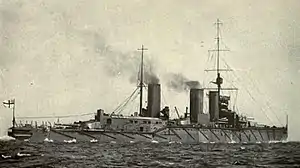 |
| SMS Lützow | Imperial German Navy | 157[24] | 1 June 1916[5] | North Sea[18] | Lützow is relatively intact, upside down, in 144 feet (44 m) of water[19] | — |
 |
| HMS Hood | Royal Navy | 1,415[25] | 24 May 1941[26] | Denmark Strait[26] | In pieces in 9,200 feet (2,800 m) of water[27] | Two of Hood's 5.5-inch (140 mm) guns, removed earlier during a refit, were installed on Ascension Island where the battery still exists today in a largely intact condition.[28] | _-_March_17%252C_1924.jpg.webp) |
| HMS Repulse | Royal Navy | 513[29] | 10 December 1941[30] | South China Sea[30] | Almost upside down in 177 feet (54 m) of water[31] | — |
 |
Scuttled battlecruisers
Several battlecruisers were scuttled.
| Name | Navy | Date sunk | Location | Condition | Relics | Image |
|---|---|---|---|---|---|---|
| SMS Von der Tann | Imperial German Navy | 21 June 1919[32] | Scapa Flow[32] | Raised and salvaged at Scapa Flow, 7 December 1930, broken up for scrap[33] | — |
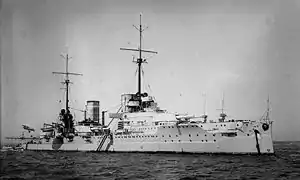 |
| SMS Moltke | Imperial German Navy | 21 June 1919[34] | Scapa Flow[34] | Raised 10 June 1927, broken up for scrap[35] | — |
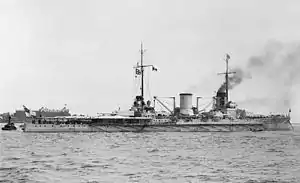 |
| SMS Seydlitz | Imperial German Navy | 21 June 1919[36] | Scapa Flow[36] | Raised November 1928, broken up for scrap[36] | Ship's bell in the Laboe Naval Memorial[37] | .jpg.webp) |
| SMS Derfflinger | Imperial German Navy | 21 June 1919[34] | Scapa Flow[34] | Raised in 1939, broken up for scrap[34] | Ship's bell outside the Church of St Michael on the Outer Hebrides island of Eriskay[38] | 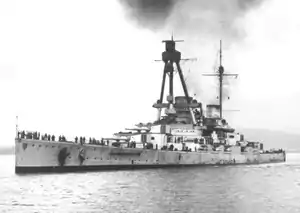 |
| SMS Hindenburg | Imperial German Navy | 21 June 1919[39] | Scapa Flow[39] | Raised 22 July 1930, broken up for scrap[37] | Ship's bell in the Laboe Naval Memorial[37] |  |
| HMAS Australia | Royal Australian Navy | 12 April 1924[40] | Off Sydney Heads[41] | At a depth of 1,332 feet (406 m)[42] | Various artifacts, including a propeller at the Australian War Memorial[43] | 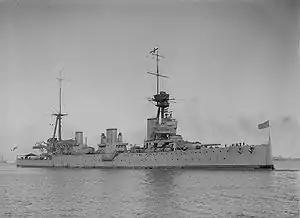 |
Converted battlecruisers
Several battlecruisers were converted into other ship types either during construction or after entering service; many of these ships were sunk in combat during World War II.
| Name | Navy | Conversion | Casualties | Date sunk | Location | Condition | Image |
|---|---|---|---|---|---|---|---|
| HMS Courageous | Royal Navy | Aircraft carrier | 519[44] | 17 September 1939[44] | Western Approaches[44] | Unknown | .jpg.webp) |
| HMS Glorious | Royal Navy | Aircraft carrier | 1,207[45] | 8 June 1940[46] | North Sea[46] | Unknown |  |
| USS Lexington | US Navy | Aircraft carrier | 216[47] | 8 May 1942[47] | Coral Sea[47] | In 3 pieces 10,000 feet (3,000 m) below the surface. | _leaving_San_Diego_on_14_October_1941_(80-G-416362).jpg.webp) |
| Akagi | Imperial Japanese Navy | Aircraft carrier | 267[48] | 5 June 1942[49] | Off Midway Island[49] | Unknown | 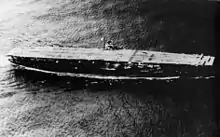 |
| Hiei | Imperial Japanese Navy | Battleship | 188[13] | 14 November 1942[49] | Ironbottom Sound[49] | Unknown | 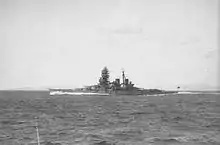 |
| Kirishima | Imperial Japanese Navy | Battleship | 212[14] | 15 November 1942[49] | Ironbottom Sound[49] | Upside down in 4,000 feet (1,200 m) of water, bow missing (separated from main hull, condition unknown).[19] |  |
| Kongō | Imperial Japanese Navy | Battleship | 1,250[15] | 21 November 1944[49] | Formosa Strait[49] | Unknown |  |
| Haruna | Imperial Japanese Navy | Battleship | 65[16] | 24 July 1945[49] | Kure[49] | Scrapped, 1946[49] |  |
| USS Saratoga | US Navy | Aircraft carrier | 0[11] | 25 July 1946[11] | Bikini Atoll[11] | Saratoga is upright, with the top of the bridge 50 feet (15 m) below the surface, largest WWII Carrier accessible to divers.[50] | _underway%252C_circa_in_1942_(80-G-K-459).jpg.webp) |
See also
Notes
- The German Scharnhorst-class battleships and Deutschland-class cruisers and the French Dunkerque-class battleships are all sometimes referred to as battlecruisers, although the owning navies referred to them as "battleships" (German: Schlachtschiffe), "armored ships" (German: Panzerschiffe) and "battleships" (French: Bâtiments de ligne) respectively. Since neither their operators nor a significant number of naval historians classify them as such, they are not discussed in this article.[1][2]
Footnotes
- Gröner, pp. 31, 60
- Gille, p. 139
- Breyer, pp. 48–49
- Campbell, pp. 368–69
- Tarrant 2001, p. 249
- Stephen, pp. 70–80, 104–14
- Herwig, p. 256
- Duncan, p. 32
- Burt, pp. 282–83, 297–98
- Polmar & Genda, pp. 50, 218, 220
- Fry, pp. 158–59
- Parshall and Tully, pp. 352–53, 463, 466
- Hackett, Bob; Kingsepp, Sander; Ahlberg, Lars (2010). "IJN Hiei: Tabular Record of Movement". Combinedfleet.com. Retrieved 6 June 2013.
- Hackett, Bob; Kingsepp, Sander; Ahlberg, Lars (2010). "IJN Kirishima: Tabular Record of Movement". Combinedfleet.com. Retrieved 6 June 2013.
- Stille, p. 20
- Hackett, Bob; Kingsepp, Sander; Ahlberg, Lars (2012). "IJN Haruna: Tabular Record of Movement". Combinedfleet.com. Retrieved 6 June 2013.
- Campbell, p. 159
- Roberts, pp. 122–23
- Duncan, p. 71
- Tarrant 1986, p. 114
- Campbell, p. 61
- "Equipment, Lifebelt (HMS Indefatigable), British". Imperial War Museum. Retrieved 6 June 2013.
- Williams, p. 132
- Tarrant 2001, p. 298
- "HMS Hood Association: Frequently Asked Questions". HMS Hood Association. Retrieved 6 June 2013.
- Stephen, p. 80
- Mearns and White, pp. 195–96
- "HMS Hood's 5.5" Guns on Ascension Islands". HMS Hood Association. 4 April 2010. Retrieved 6 June 2013.
- Stephen, p. 114
- Stephen, p. 108
- Denlay, p. 6
- Staff, p. 11
- Gröner, p. 54
- Staff, p. 17
- Gröner, p. 55
- Staff, p. 33
- Gröner, p. 57
- "Eriskay St Michael's R.c. Church, South Uist". British Listed Buildings. Retrieved 7 June 2013.
- Staff, p. 42
- Duncan, p. 34
- Sears, in Stevens, The Royal Australian Navy, p. 65
- Duncan, p. 73
- Duncan, pp. 93–95
- Burt, pp. 289–90
- Winton, p. 200
- Rohwer, p. 26
- Polmar and Genda, pp. 218, 220
- Parshall and Tully, p. 476
- Jentschura, Jung and Mickel, p. 35
- "Bikini Atoll Dive Tourism Information". Bikini Atoll Divers. Retrieved 26 November 2012.
References
- Breyer, Siegfried (1973). Battleships and Battle Cruisers 1905–1970. Garden City, New York: Doubleday. ISBN 978-0-385-07247-2.
- Burt, R. A. (2012) [1993]. British Battleships, 1919–1939. Annapolis, Maryland: Naval Institute Press. ISBN 978-1-59114-052-8.
- Campbell, John (1998). Jutland: An Analysis of the Fighting. New York: Lyons Press. ISBN 1-55821-759-2.
- Denlay, Kevin (2007). "Expedition Job 74" (PDF). Explorers.org. Retrieved 6 June 2013.
- Duncan, Brad (July 2011). Battlecruiser HMAS Australia (1): Wreck Inspection Report (PDF) (Report). Parramatta, NSW: Heritage Branch, NSW Office of Environment and Heritage. OCLC 754127975. Retrieved 26 December 2012.
- Fry, John (1996). USS Saratoga CV-3: An Illustrated History of the Legendary Aircraft Carrier 1927–1946. Atglen, Pennsylvania: Schiffer Publishing. ISBN 0-7643-0089-X.
- Gille, Eric (1999). Cent ans de cuirassés français. Nantes: Marines. ISBN 2-909-675-50-5.
- Gröner, Erich (1990). German Warships: 1815–1945. Annapolis, Maryland: Naval Institute Press. ISBN 978-0-87021-790-6.
- Herwig, Holger (1998) [1980]. "Luxury" Fleet: The Imperial German Navy 1888–1918. Amherst, New York: Humanity Books. ISBN 978-1-57392-286-9.
- Jentschura, Hansgeorg; Jung, Dieter; Mickel, Peter (1977). Warships of the Imperial Japanese Navy, 1869–1945. Annapolis, Maryland: United States Naval Institute. ISBN 0-87021-893-X.
- Mearns, David; White, Rob (2001). Hood and Bismarck: The Deep Sea Discovery of an Epic Battle. London: Channel 4. ISBN 0-7522-2035-7.
- Parshall, Jonathan; Tully, Anthony (2007). Shattered Sword: The Untold Story of the Battle of Midway. Washington: Potomac Books. ISBN 978-1-57488-924-6.
- Polmar, Norman; Genda, Minoru (2006). Aircraft Carriers: A History of Carrier Aviation and Its Influence on World Events. Volume 1, 1909–1945. Washington, D.C.: Potomac Books. ISBN 1-57488-663-0.
- Roberts, John (1997). Battlecruisers. Annapolis, Maryland: Naval Institute Press. ISBN 1-55750-068-1.
- Rohwer, Jurgen (2005). Chronology of the War at Sea, 1939–1945: The Naval History of World War Two. Annapolis, Maryland: Naval Institute Press. ISBN 1-59114-119-2.
- Sears, Jason (2001). "An Imperial Service". In Stevens, David (ed.). The Royal Australian Navy. The Australian Centenary History of Defence. III. South Melbourne, VIC: Oxford University Press. ISBN 0-19-555542-2. OCLC 50418095.
- Staff, Gary (2006). German Battlecruisers: 1914–1918. Oxford, UK: Osprey Books. ISBN 978-1-84603-009-3.
- Stephen, Martin (1988). Sea Battles in Close-Up: World War 2. Annapolis, Maryland: Naval Institute Press. ISBN 0-87021-556-6.
- Stille, Mark (2008). Imperial Japanese Navy Battleships 1941-45. New Vanguard. 146. Oxford, UK: Osprey Publishing. ISBN 978-1-84603-280-6.
- Tarrant, V. E. (1986). Battlecruiser Invincible: The History of the First Battlecruiser, 1909–16. Annapolis, Maryland: Naval Institute Press. ISBN 0-87021-147-1.
- Tarrant, V. E. (2001) [1995]. Jutland: The German Perspective. London: Cassell Military Paperbacks. ISBN 978-0-304-35848-9.
- Williams, M. W. (1996). "The Loss of HMS Queen Mary at Jutland". Warship 1996. London: Conway Maritime Press. pp. 111–32. ISBN 0-85177-685-X.
- Winton, John (1986). Carrier Glorious. London: Leo Cooper, Secker & Warburg. ISBN 0-436-57806-9.